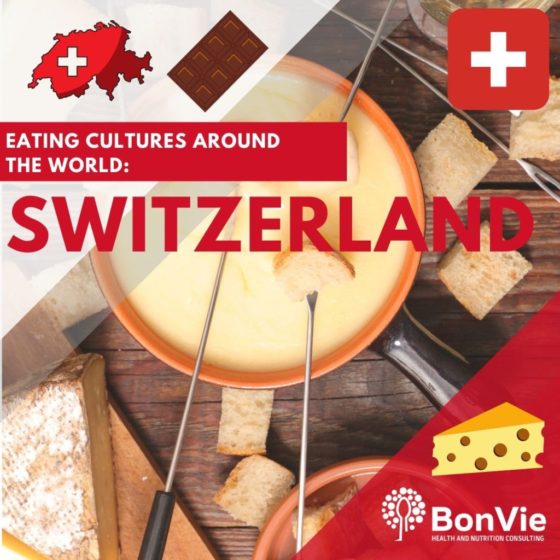
24 Jan Eating Cultures Around the World: Switzerland
For a long time, Switzerland was coined as the European country with the lowest rate of obesity. That was until 2015, when obesity rates in Switzerland rose to 15% (as they did in many developed countries worldwide). Not surprisingly, this increase occurred with the increase in access to processed and convenience foods. Today, Switzerland remains a European country with one of the lowest obesity rates and a significantly lower obesity rate than western nations.
Swiss diets are calorically dense, being high in dairy products like butter, cream, cheese, yogurt, and milk; chocolate; red and processed meats like pork or sausage; and starchy products, like cereals, bread, or pastries.
So…why are Swiss lifestyles are often thought to be healthier than the diets and lifestyles we lead here in the U.S.? One major reason is their high level of outdoor activity – the Swiss tend to walk anywhere within walking distance.
Another reason? Snacks and meals with reasonable portions! In Switzerland, five meals are typically enjoyed daily: Zmorge (early breakfast), Zuni (later breakfast or mid-morning snack), Zmittag (lunch), Zvieri (afternoon snack), and Znacht (dinner).
Breakfast is enjoyed earlier in the morning around 6:30 or 7:30 AM. Breakfast on the weekend is usually enjoyed later around 9:00 AM and is much larger than weekday breakfasts. Typical breakfast foods include bread with butter and jam, cereal with milk, Muesli with fruit, yogurt, Swiss croissants called Gipfeli, coffee, and tea. On the weekends, breakfast is much longer and more leisurely. Typical weekend breakfast additions include items like eggs, bacon, cheeses, deli meats and potato pancakes called Roschti.
The second meal, Znuni, literally means ‘at nine’, and is usually enjoyed between breakfast and lunch around 9:00AM. Schools and workplaces allocate time for this mid-morning snack. Typical snack items include fruit, rolls, croissants, coffee, tea, and juice.
The third meal of the day is lunch, which is usually enjoyed around noon. In recent years, lunch in Switzerland has become less representative of the Swiss culture and more representative of other cultures worldwide. During lunch, the Swiss like to get hot meals from Italian, Chinese, Thai or vegan restaurants for example. There are traditional Swiss meals like soups and ragouts that can be enjoyed, but international food items have become more popular. 12:00 to 1:00 PM is considered a ‘quiet hour’ meant for rest and recuperation.
The fourth meal of the day, or Zvieri, literally means ‘at four’. This mid-afternoon snack typically includes food items like sandwiches, pastries, cookies, fruit and peanuts. Ice cream is also popular during the summer time as a mid-afternoon snack.
The last meal of the day is typically enjoyed around 6:00 or 7:00PM. Dinner usually consists of cold foods, as opposed to lunch which is usually hot. Loaves of bread, butter, cheese, cold cuts, jam, honey, soups, fried eggs, and leftovers from lunch are commonly enjoyed. Popular vegetables include beans, carrots, cauliflower, potatoes and spinach. Common side dishes include pasta, potatoes, french fries, or rice. Typical Swiss meat selections include veal, beef, pork, chicken or turkey which can be either in sausage form, grilled, or sliced into cold-cuts.
So how can they eat all of this food and stay in shape? The answer comes down to portion size and lack of food obsession.
In Switzerland, discussion of diets and calorie amounts are extremely uncommon. For the most part, the Swiss eat their meals intuitively and they eat real, whole, full fat versions of foods and nothing ‘light’.
Meals are considered a time for social gathering rather than a time exclusively for eating. Although eating is a part of dining in Switzerland, spending time with family and friends and eating at a slow and leisurely pace are the norm.
So, let’s take a cue from the Swiss and stop obsessing about our “lighter” versions! Go for the good stuff (in sensible portions), enjoy some quiet time in your meal, focus on socializing and slowing down, and walk it all off. Not a complicated diet, but the plan works!


Aurora4746
Posted at 04:40h, 17 Aprilhttps://hrv-club.ru/forums/index.php?autocom=gallery&req=si&img=6889